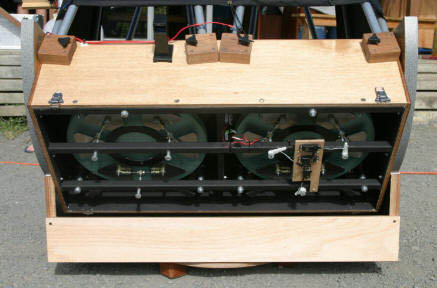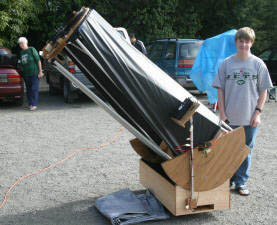Dave's 16 Inch Binocular Telescope Page
Any telescope can be broken down into two main
essential elements. Firstly the optics, there are multiple different optics
designs that are suitable for use in astronomical telescopes. The one that I
have chosen to use is just a slight variation on the standard Newtonian design.
The variation is that in a binocular Newtonian you need the third mirror to fold
the two separate light cones so they are once again parallel and able to be fed
to two eyepieces to your eye's.
The second major element in the telescope is the structure supporting the optics. This needs to fulfil a large number of often conflicting requirements. Its main job however is to allow all the optics to be held perfectly in alignment with each other while being able to be pointed at any part of the sky and often to also track the sky simultaneously. This is no mean task as often the structure flexes and bends under its own weight putting the optics out of alignment. In the binocular telescope the alignment of the optics is much more critical than with a standard monocular telescope. This more stringent requirement is mainly brought about by the need to have the optics aligned so that the eyes and a brain are able to merge the two separate images that are being presented to them.
There have been two main schools of thought as
to how to approach this problem. The first approach has been to simply get two
separate optical assemblies that are both capable of having their individual
optics collimated separately, then the using a system of hinges and sliding
platforms, to maneuver the two independent tubes so that are merged image is
presented at the eyepiece. The main difficulty this type of construction is the
complexity of the mechanisms needed to independently move while still holding
rigid the two separate tube assemblies.
The second approach, the one that I have taken. Is to have the top end of the telescope and the bottom end completely rigid structures. The top end is two rings joined together and the mirror cell is one solid unit. This makes the whole structure move as one and any sag in any part is exactly the same on the other side keeping the optics aligned to each other. In order to make the optic paths parallel the primary mirrors are able to move in XY direction. They are also held firmly in place by piano wire edge supports, rather than that a traditional sling system. I am now convinced of the merits of this style of design compared with the independent tube idea. The entire structure is a rigid, the movement is smooth, it's rock solid with no vibration and easy for a number of users to view one after another with little or no adjustment. You do need a cool methodical approach to collimating this instrument but once it is achieved it is a pleasure to use.